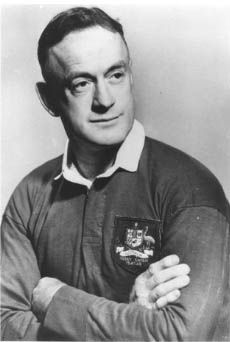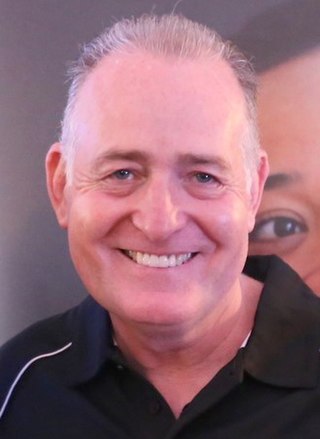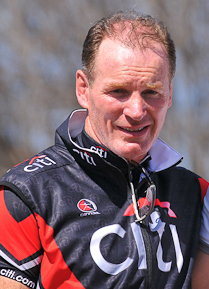Related Research Articles

The Australia national rugby union team, nicknamed the Wallabies, is the representative national team in the sport of rugby union for the nation of Australia. The team first played at Sydney in 1899, winning their first test match against the touring British Isles team.

Cyril Towers was an Australian rugby union player, a state and national representative centre who made 57 appearances for the Wallabies, played in 19 Test matches and captained the national side on three occasions in 1937.

Matthew Coleman Burke is an Australian former international rugby union player and sport presenter on Sydney's 10 News First.

David Ian Campese, AM, also known as Campo, is a former Australian rugby union player (1982–1996), who was capped by the Wallabies 101 times, and played 85 Tests at wing and 16 at fullback.
Michael Patrick Thomas Lynagh, is an Australian former rugby union player who played mainly as a fly-half. Lynagh represented Australia from 1984 to 1995, playing at both inside centre and fly half. Lynagh was capped 72 times for Australia, and was captain from 1993 to 1995. He was the world points scoring record holder when he retired, with 911 points.

Simon Paul Poidevin is a former Australian rugby union player. Poidevin made his Test debut for Australia against Fiji during the 1980 tour of Fiji. He was a member of the Wallabies side that defeated New Zealand 2–1 in the 1980 Bledisloe Cup series. He toured with the Eighth Wallabies for the 1984 Australia rugby union tour of Britain and Ireland that won rugby union's "grand slam", the first Australian side to defeat all four home nations, England, Ireland, Wales and Scotland, on a tour. He debuted as captain of the Wallabies in a two-Test series against Argentina in 1986, substituting for the absent Andrew Slack. He was a member of the Wallabies on the 1986 Australia rugby union tour of New Zealand that beat the All Blacks, one of six international teams and second Australian team to win a Test series in New Zealand. During the 1987 Rugby World Cup, he overtook Peter Johnson as Australia's most capped Test player against Japan, captaining the Wallabies for the third time in his 43rd cap. He captained the Wallabies on a fourth and final occasion on the 1987 Australia rugby union tour of Argentina before injury ended his tour prematurely. In 1988, he briefly retired from international rugby, reversing his decision 42 days later ahead of the 1988 Bledisloe Cup series. Following this series, Poidevin returned to the Australian side for the single 1989 Bledisloe Cup Test. He returned full-time to the Australian national squad for the 1991 season. Poidevin was a member of the Wallabies that won the 1991 Rugby World Cup, after which he retired from international rugby union.
Nicholas Campbell Farr-Jones AM is a former Australian rugby union footballer. His position was scrum-half. Farr-Jones debuted for the Australia national rugby union team during the 1984 Australia rugby union tour of Britain and Ireland, during which the Australia won the grand slam of rugby union when they defeated all four Home Nations. He was voted "Player of the Series" for the 1986 Australia rugby union tour of New Zealand, during which Australia became the sixth team in history to win a rugby Test series in New Zealand. He was appointed captain of the Wallabies prior to the commencement of their 1988 international season. He is probably best remembered for captaining Australia to their the 1991 Rugby World Cup. Farr-Jones retired as captain of Australia after a victory against South Africa in 1992 and temporarily ceased playing international rugby. He came out of retirement in 1993 for the single Bledisloe Cup Test and a three-Test home series against South Africa, following which he retired from international rugby. He now works at Taurus Funds Management, appears as a TV rugby commentator on UK Sky Sports and is the chairman of the New South Wales Rugby Union.
Kenneth William Catchpole was an Australian rugby union footballer. A state and national representative half-back, he played twenty-seven matches for Australia, thirteen as captain. Catchpole rose through the ranks at the Randwick club as a young man, before making his debut for New South Wales at only 19 years of age, then captaining Australia at age 21. He is considered one of Australia's greatest rugby scrumhalves.
Alexander Douglas McLean Jr. was an Australian rugby union and rugby league player, a dual-code rugby international.
Brendan Moon is an Australian former rugby union wing who played for the Queensland Reds in the late 1970s and early 1980s. Moon played 100 games for Queensland and also played in the premiership winning Brothers Old Boys team of 1978, 1980–1983, Brendan also represented Australia in 35 tests and was considered one of the best finishing wingers in the game with excellent positional play and terrific acceleration.
Andrew Gerard Slack is an Australian former state and national representative rugby union player who captained the Wallabies in 19 Test matches in between 1984 and 1987. His 133 appearances for Queensland between 1975 and 1987 stood as the state record until bettered by Mark Connors in 2006.
The 1984 Australia rugby union tour of Britain and Ireland was a series of eighteen matches played by the Australia national rugby union team in Britain and Ireland between 17 October and 15 December 1984. The Australian team won thirteen matches, drew one and lost four but notably won all four of their international matches.
Colin "Col" Windon, was a rugby union player and soldier who captained Australia – the Wallabies – in two Test matches in 1951. By age 18 Windon was playing at flanker for his club Randwick in Sydney's Shute Shield. After serving with the Second Australian Imperial Force in the Pacific Theatre during the Second World War, Windon resumed his rugby career in 1946. He was first selected for Australia for their tour of New Zealand that year. Despite the Wallabies losing both their Tests on tour, Windon impressed with his play.
Steve Williams is an Australian former state and national representative rugby union player who captained the Wallabies in five Test matches in 1985.

Anthony Alexander Shaw is an Australian former rugby union player. A Queensland state and national representative flanker, Shaw captained the national side consistently from 1978 to 1982.
The 1981–82 Australia rugby union tour of Britain and Ireland was a series of matches played by the Australia national rugby union team. The touring team played twenty-three matches between October 1981 and January 1982, winning sixteen games, drawing one and losing six. The scheduled final game, against the Barbarians, was cancelled due to heavy snow.
The 1982 Australia rugby union tour of New Zealand was a series of fourteen matches played by the Australia national rugby union team in New Zealand between July and September 1982. The Wallabies won ten of the fourteen matches and lost the other four. The international match series against the New Zealand national rugby union team resulted in a 2–1 win for New Zealand, who won the first and third matches, with Australia winning the second match. New Zealand thereby regained the Bledisloe Cup, which had been held by Australia since 1979.
Paul Edward McLean, MBE is an Australian former rugby union player. He played rugby for Queensland and Australia in the 1970s and 1980s, He is a former president of the Queensland Rugby Union, Australian Rugby Union, and an inductee into the Australian Rugby Union Hall of Fame. From 2009 to 2015 he was Chief Executive Officer for Savills, overseeing the Australasian operations of the multinational real estate services provider.
The 2013 Australia national rugby union team tour of Great Britain, Ireland and Italy was a rugby union tour between the away team Australia and the homes teams of England, Ireland, Italy, Scotland and Wales. They also played an additional Test match against New Zealand, which acted as the third and final Bledisloe Cup match for 2013.
Roger Gould is a former rugby union player who played fullback for both the Australian Wallabies and the Queensland Reds. He first played for Queensland in 1978 and for Australia in 1980. His last match for Australia was in the 1987 World Cup. Although Gould's career was cut short due to injury, he is widely considered one of the greatest fullbacks to ever play for Australia.
References
- Clarke, David; Mason, Roy and Samuelson, Stephen (1999) Test Rugby Lists, Noble Park, Victoria: The Five Mile Press
- Campese, David; Bills, Peter (1991). On a Wing and a Prayer. Queen Anne Press. ISBN 0-356-17958-3.
- Campese, David; Meninga, Mal; Jenkins, Peter; Frilingos, Peter (1994). My Game Your Game: David Campese and Mal Meninga Talk Football. Pan Macmillan Australia. ISBN 9780330356169.
- Derriman, Philip (2003). The Rise & Rise of Australian Rugby. ABC Books. ISBN 0-7333-1329-9.
- Dwyer, Bob (1992). The Winning Way. Rugby Press. ISBN 0-908630-41-7.
- Dwyer, Bob (2004). Full Time: A Coach's Memoir. Pan Macmillan Australia. ISBN 1-40503608-7.
- Ella, Mark; Smith, Terry (1987). Path to Victory: Wallaby Power in the 1980s. ABC Enterprises. ISBN 0-642-52766-0.
- Ella, Mark (1995). Running Rugby. ABC Books. ISBN 0-7333-0359-5.
- Edwards, Gareth (1987). 100 Great Rugby Players. Queen Anne Press. ISBN 0-356-14200-0.
- Harris, Bret (1984). Ella, Ella, Ella. Little Hills Press. ISBN 0-949773-07-7.
- Harris, Bret (1991). The Best of Both Worlds – The Michael O'Connor Story. Macmillan. ISBN 978-0-7329-0745-7.
- Harris, Bret; Ella, Mark (2007). Ella: The Definitive Biography. Random House Australia. ISBN 978-1-74166-691-5.
- Jenkins, Peter (2003). Wallaby Gold: The History of Australian Test Rugby. Random House Australia. ISBN 0-091-83928-9.
- Poidevin, Simon; Webster, Jim (1992). For Love Not Money: The Simon Poidevin Story. ABC Books. ISBN 978-0-7333-0208-4.